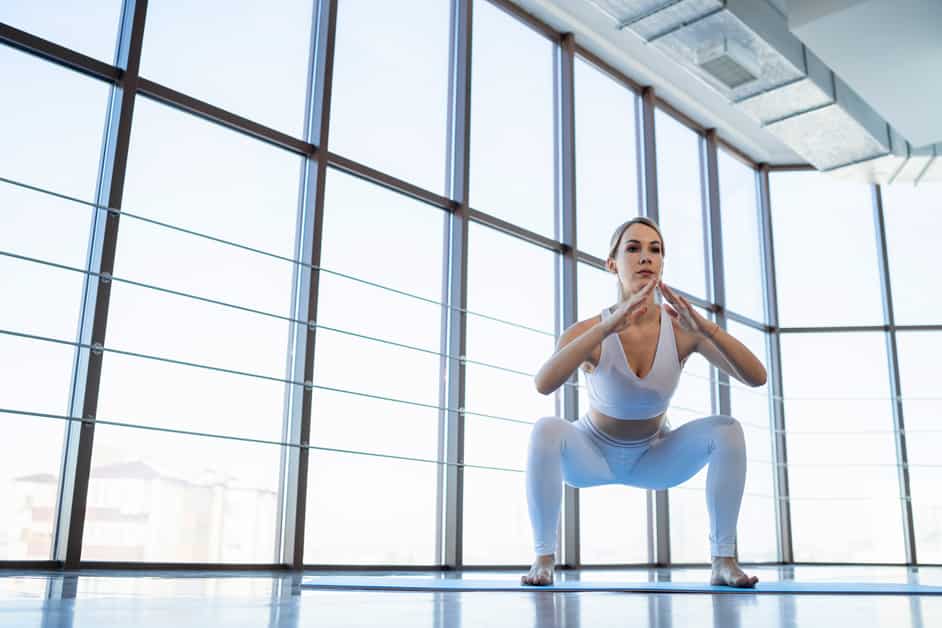Introduction
The squat is a common movement pattern for many exercises and activities. We all know the ‘gym-style’ squat, used for weightlifting. But, do you know the ‘yoga squat’? It’s not as popular. So, what are the differences?
This article will discuss which type of squat is best to relieve knee pain. We’ll look at things like range of motion, technique, muscle activation, etc. By understanding the squats and their benefits for knee pain, you can pick the one that works best for you and your goals.
Anatomy of a Squat
Squats are a popular exercise for strengthening hip and knee muscles. To understand the difference between a regular squat and a yoga squat, and which one is better for knee pain, we must understand the anatomy of a squat.
The following topics will be covered:
- Muscles used during a squat.
- The differences between a regular and yoga squat.
- Which one is best for knee pain.
Regular Squat
Squats are the key to any successful strength-training program. Everyone should do them regularly. This exercise gets your whole lower body and core working.
To squat:
- stand with your feet wider than hip-width apart, toes pointing outwards about 10-15 degrees.
- Then lower yourself like you’re sitting in a chair. Keep your back straight and chest up.
- Stop when your hips are just below parallel.
- Push through your heels to stand back up and use your core.
Start with 8-10 reps and 1-2 sets. As you get stronger, build up to higher reps. Challenge yourself by adding weights like dumbbells or a barbell at the end of sets.
Yoga Squat
The Yoga Squat, also known as the Malasana squat, is a unique type of squat. It’s part of yoga and focuses on body awareness. It differs from a conventional squat in four ways:
- The feet are positioned wider than hip-width apart with the toes pointed outward. This gives more stability to your knees and hips.
- Keep your spine straight and bring your torso forward to fill up space. Sink into the movement, not push through it.
- Use a blanket or other padding to support your knees if you have knee pain.
- Work up to deeper squats until both heels come off the floor. Fully extend your hamstrings and hip flexors before returning back to center. Control your breath-hold cycle before repeating on each side.
Benefits of Squatting
Squatting is a top way to make your legs, booty and core strong and firm. It’s thought of as super important for keeping fit and avoiding harm. There are two main sorts of squats – the regular one and the yoga one. Let’s look at the positives of each and find out which is best for knee pain.
Regular Squat
Squats are a top exercise for boosting body strength and toning muscles. Doing them regularly can help you stay in shape, keep lower back safe, and even strengthen your hips and knees. Plus, you’ll get improved posture and better flexibility.
For a good squat, stand with your feet shoulder-width apart, chest up, abs tight, eyes on the horizon. Stay in correct form to prevent injury and gain more mobility. You’ll also get stronger glutes and connective tissue, better balance and a bigger range of motion. For strength training, go lighter on the weights and higher on the reps for faster results.
Yoga Squat
The yoga squat is great for those starting out. It’s safe and effective. It stretches the lower body, strengthens your core and helps improve balance. When done right, it demands focus and deep breathing. As flexibility increases, many people can stay in the pose for longer.
Yoga squats can help with lower back pain. They loosen tight muscles around the spine and exercise them too, improving back strength and stability. It also boosts hip mobility, which can help with everyday activities like walking or running, and more intense exercises.
Knee Pain and Squatting
Squats are a go-to exercise for knee muscle strengthening. They can also help with certain kinds of knee pain. But what kind of squat is best? Let’s explore the pros and cons of the two most popular types – regular squats and yoga squats. Then, we’ll look at how each can help relieve knee pain.
Regular Squat
The regular squat is a great way to build strength and protect knee joints. Position your feet shoulder width apart and your hands hip-width apart. Sit back, keeping your upper body upright and core engaged. Your butt should lightly tap the back of your calves. Hold this position for a second before pushing up through your heels to stand.
Adding variation can strengthen core muscles. Make sure proper form is maintained by engaging your glutes and keeping your knees in line with your toes. To increase difficulty level, use weights or bands around legs. If you experience knee pain, an incline element can provide more support while still giving a challenging workout.
Yoga Squat
The yoga squat is an awesome way to stretch and strengthen the muscles and joints related to your knees. It targets the quadriceps, hamstrings, glutes, calves, and inner thighs.
To do the yoga squat:
- Stand with feet slightly wider than shoulder width, legs and arms straight.
- Bend from the hips, hands outwards, like in a diving position.
- Keep your back flat. Put your hands on the ground or on a cushion or block for support, if needed.
- Keep your spine neutral. Dip into a comfortable squat, knees wide but not past toes. Use your breath to go deeper. Inhale as you descend, exhale as you rise.
- Optionally, bend your torso to one side, extending one arm out or burying head in chest. Do this for one minute each side.
- Optionally, reach your arms up. Do this for one minute [*Have supports nearby, in case you lose balance].
- Optionally, bring one heel up, toes pointing at ceiling. Do this on alternating sides [*Do this once you’ve built up strength in your knees].
Conclusion
It is hard to say which squat is better for relieving knee pain – the yoga squat or the regular squat – since everyone’s body and needs are unique.
Generally, if you suffer from chronic knee pain, a yoga squat is likely the better option. It focuses on deep stretching and relaxation, which can aid in relieving the pain. But if you experience acute knee pain, a regular squat is more beneficial. It boosts movement in the knee joint, which can help bring back stability and flexibility.
Remember to speak to your doctor or physical therapist before you attempt either exercise. To reduce discomfort and enhance mobility in the long run, make sure to stick to an effective stretching routine:
Frequently Asked Questions
Q: What is the difference between yoga squats and regular squats?
A: Yoga squats are an exercise that focuses on the hips and thighs, and can be done with or without weights. Regular squats target the quadriceps, glutes and hamstrings, and are typically done with weights.
Q: Which type of squat is best for knee pain?
A: Yoga squats can be a great option for those with knee pain, as they are a low impact exercise that puts less pressure on the joints. Regular squats can also be beneficial for knee pain, as long as you are using proper form and taking it slow.
Q: What kind of knee pain can squats help relieve?
A: Squats can help with knee pain caused by weak muscles, inflammation, and other conditions. Squats can help strengthen the muscles around the knee joint, which can reduce pain and improve stability.





